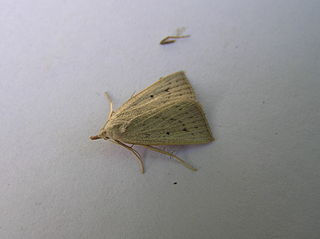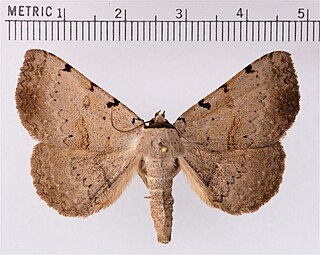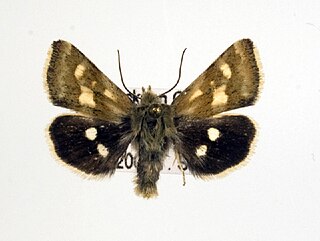
Chytolita is a monotypic litter moth genus of the family Erebidae erected by Augustus Radcliffe Grote in 1873. Its only species, Chytolita morbidalis, the morbid owlet moth or morbid owlet, was first described by Achille Guenée in 1854. It is found in large parts of North America, from coast to coast in the north and south to North Carolina, Texas and Florida in the west. The habitat consists of deciduous woods and edges.

Macrochilo is a genus of litter moths of the family Erebidae. The genus was erected by Jacob Hübner in 1825.

Phalaenophana is a genus of litter moths of the family Erebidae. The species was first described by Augustus Radcliffe Grote in 1873.

Phalaenostola is a genus of litter moths of the family Erebidae. The genus was erected by Augustus Radcliffe Grote in 1873.

Spiloloma is a monotypic moth genus in the family Erebidae. Its only species, Spiloloma lunilinea, the moon-lined moth, is found in eastern and south-central North America. Both the genus and species were first described by Augustus Radcliffe Grote in 1873.

Tetanolita is a genus of litter moths of the family Erebidae. The genus was erected by Augustus Radcliffe Grote in 1873.

Mellilla is a monotypic moth genus in the family Geometridae erected by Augustus Radcliffe Grote in 1873. Its only species, Mellilla xanthometata, the orangewing moth, was first described by Francis Walker in 1862. It is found in most of eastern North America.

Catocala meskei, or Meske's underwing, is a moth of the family Erebidae. The species was first described by Augustus Radcliffe Grote in 1873. It is found in North America from Maine and Quebec west to southern Alberta and Montana, south to South Carolina in the east and at least Montana in the west.
Pygarctia spraguei, also known as Sprague's pygarctia or Sprague's tiger moth, is a moth of the family Erebidae. It was described by Augustus Radcliffe Grote in 1875. It is found in North America from the Great Plains of southern Canada to Texas, westward to Utah, eastward to Indiana and Louisiana.

Caenurgina is a genus of moths in the family Erebidae.

Caenurgina annexa, the banded grass moth, is a moth of the family Erebidae. The species was described by Henry Edwards in 1890. It is found in western North America from western Alberta and Montana to British Columbia, Washington, and Oregon.

Caenurgina crassiuscula, the clover looper or range grass moth, is a moth of the family Erebidae. The species was first described by Adrian Hardy Haworth in 1809. It is found from coast to coast in the United States and adjacent parts of Canada, in the west to the Northwest Territories, Yukon, and Alaska.

Caenurgina erechtea, the forage looper or common grass moth, is a moth of the family Erebidae. The species was first described by Pieter Cramer in 1780. It is found from coast to coast in the United States and adjacent parts of Canada. It is not found in Newfoundland, New Brunswick, Prince Edward Island, Yukon, or the Northwest Territories. The wingspan is 30–42 mm. Adults are on wing from March to November depending on the location.

Heliothodes diminutivus, the small heliothodes moth, is a moth of the family Noctuidae. The species was first described by Augustus Radcliffe Grote in 1873. It is found in the western US from California, through Oregon to Washington.

Macrochilo litophora, the angulate fan-foot or brown-lined owlet moth, is a litter moth of the family Erebidae. The species was first described by Augustus Radcliffe Grote in 1873. It is found in the United States from Wisconsin, east to Massachusetts, south to North Carolina, South Carolina, Mississippi and Texas.

Phalaenostola larentioides, the black-banded owlet, is a moth of the family Erebidae. The species was first described by Augustus Radcliffe Grote in 1873. It is found in North America from New Brunswick and Wisconsin to Maine, south to Florida and Texas, west to Ontario.
Spargaloma is a monotypic moth genus in the family Erebidae. Its only species is Spargaloma sexpunctata, the six-spotted gray. Both the genus and species were first described by Augustus Radcliffe Grote in 1873. It is found from coast to coast in lower Canada south in the east to Florida, Mississippi and Arkansas, in the west to California.
Sitochroa chortalis, the dimorphic sitochroa moth, is a moth in the family Crambidae. It was described by Augustus Radcliffe Grote in 1873. It is found in North America, where it has been recorded from Nova Scotia to southern British Columbia, south to New Jersey, Arizona and northern California. The habitat consists of grassland and prairie areas.
Stiriina is a subtribe of owlet moths in the family Noctuidae. There are at least 50 described species in Stiriina.
Stiriini is a tribe of owlet moths in the family Noctuidae. There are at least 120 described species in Stiriini.












